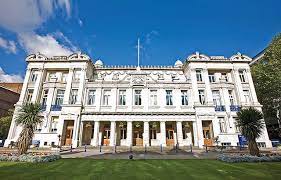Queen Mary University of London: Queen Mary researcher discovers rare manuscript fragments hidden in library
Dr Tamara Atkin, an English literature specialist and book historian from Queen Mary University of London, has discovered two rare manuscript fragments hidden away in a 16th-century book in the Bodleian Library in Oxford. One tells part of the story of Tristan and Iseult, among the most famous star-crossed lovers of Middle Ages. The other is a fragment of a long-lost poem that scholars had thought to exist but had yet to find anywhere.
The two hand-written parchment fragments were discovered while Dr Atkin was undertaking Leverhulme Trust funded research into the reuse and recycling of old books in the Bodleian Library. Immediately suspecting their importance, she approached academics from the University of Bristol, University of Edinburgh, and University of British Columbia to help with their identification. They are now working together to analyse the two parchment fragments which are thought to come from two French poems: Béroul’s Roman de Tristan and the hitherto lost Siège d’Orange.
Béroul’s twelfth-century poem is among the earliest versions of the famed story of Tristan and Iseult – the ‘Romeo and Juliet of the Middle Ages’. Until now, the only evidence of its existence had been an incomplete thirteenth-century manuscript in the Bibliothèque nationale de France. The new fragment, which differs significantly from the longer version, demonstrates a wider circulation for the poem than has been previously understood.
The Siège d’Orange is a lost poem from a cycle of chansons de geste – narrative poems – about Guillaume d’Orange. At just 47 lines, the new Guillaume fragment offers a tiny glimpse at what would have once been a much longer poem. But its discovery proves the existence of a poem that until now was believed to be completely lost.
The new fragment appears to be from a copy of the poem made in England written using the form of French (Anglo-Norman) that was in use in England at the time.
The fragments were found in the binding of a book published in 1528. Throughout the sixteenth century, unwanted manuscripts and printed books were frequently reused for a variety of purposes as paper and parchment were expensive commodities.
Dr Tamara Atkin of Queen Mary University of London said: “When I opened this book for the first time, I was extremely excited. It is not uncommon to find manuscripts recycled as waste in the bindings of other books, but they tend to be in Latin and often concern religion. It is relatively rare to find manuscripts containing poems written in the language of everyday life used in this way and to find two in a single book is rarer still!
“It is very likely that the manuscripts from which the fragments were taken were cut up in the bindery and used as ‘waste’ in the binding of this, and perhaps other books.
“Just as this book was the labour of many hands, I am looking forward to collaboratively revealing these fragments’ full significance.”
Pooling their expertise, the team will now attempt to discover more about the fragments’ journey, including when and where they were copied and how they came to be bound in a book printed many centuries later. They will produce full transcriptions and translations of the fragments, alongside descriptions of their manuscript and bibliographical contexts, to gain a clearer picture of their relationship to the Tristan and Guillaume traditions.

